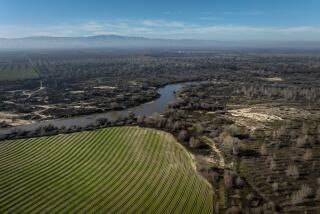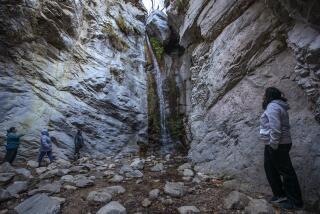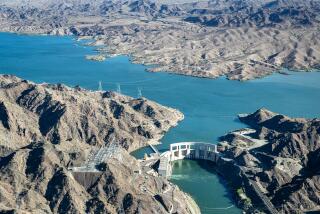Wilderness protection bill gets House OK
Congress on Wednesday approved the largest expansion of the wilderness system in 15 years, bestowing the highest level of federal protection on 2 million acres in nine states and launching one of the most ambitious river restoration efforts in the West.
The bill, the first major conservation measure set to be signed by President Obama, would designate as wilderness almost as much land as was set aside during George W. Bush’s entire presidency. It passed the House on Wednesday, 285 to 140, after clearing the Senate last week.
In California -- which now has 14 million acres of wilderness (second only to Alaska, which has more than 57 million acres) -- the bill would protect about 700,000 additional acres from new roads and most commercial uses such as new mining, logging and energy development.
Included in the legislation is $88 million to help fund a project to return year-round flows and a prized salmon run to the San Joaquin River for the first time since the 1940s. The bill also would provide $61 million toward cleanup of polluted groundwater in the San Gabriel Valley.
The legislation passed Wednesday is an amalgam of about 160 bills, including measures to strengthen the protection of Oregon’s Mt. Hood; designate President Clinton’s boyhood home in Hope, Ark., a national historic site; create a commission to plan for the 450th anniversary of the founding of St. Augustine, Fla.; and designating the River Raisin battlefield in Monroe, Mich. -- site of a bloody battle in the War of 1812 -- as a unit of the national park system.
Rep. Nick J. Rahall II (D-W.Va.), chairman of the House Natural Resources Committee, said at a news conference after the vote that the bill is the “most important piece of conservation legislation Congress has considered in many years.”
California land to be designated as wilderness includes about 40,000 acres in the San Gabriel Mountains in Los Angeles County. The bill would create the Magic Mountain Wilderness -- named for a mountain northeast of Santa Clarita, not the Six Flags amusement park -- and the Pleasant View Ridge Wilderness, west of Angeles Crest Highway.
About 428,000 acres in the Eastern Sierra would be protected, as would about 147,000 acres in Riverside County (including parts of Joshua Tree National Park) and about 85,000 acres in Sequoia-Kings Canyon National Parks -- including the Mineral King Valley area that was the site of an environmental battle in the 1960s when the Disney company tried to build a ski resort there.
The legislation also would strengthen protections of scenic rivers, including eight in California that stretch from the upper Owens River in the eastern Sierra to Piru Creek in Los Angeles County.
In addition, the bill would add about 8,400 acres to the 272,000-acre Santa Rosa and San Jacinto Mountains National Monument near Palm Springs, and order a study on whether the World War II Japanese American internment camp at Tule Lake should be part of the national park system.
“We’re ecstatic,” said Sam Goldman, California wilderness coordinator at the Wilderness Society.
The bill brought together members of opposing parties who were eager to trumpet their conservation efforts and water projects.
Rep. Howard P. “Buck” McKeon of Santa Clarita, a conservative Republican who worked with liberal Sen. Barbara Boxer (D-Calif.) to push for the wilderness designation in the Eastern Sierra and San Gabriel Mountains, alluded to his unusual situation.
“We have some people who used to be my friends who are not happy with me, and we have some people who used to hate me who now think I’m great,” he said. Showing pictures of mountains and rivers in his district, he added: “Places like this are treasures that we should try to preserve.”
But the measure drew opposition from a number of congressional Republicans and business and property-rights groups, who attacked it as a land grab that would close off public land to energy production.
“If Congress and the administration are serious about jump-starting our economy, they cannot limit responsible American energy production of any kind, including oil and natural gas,” said Barry Russell, president and chief executive of the Independent Petroleum Assn. of America.
The $88 million for the San Joaquin River is aimed at ending one of California’s legendary water fights.
So much of the river is diverted to irrigate farmland on the east side of the agriculture-rich San Joaquin Valley that about 60 miles of it has turned into a bed of dust. Its lower reach is so polluted with runoff and agricultural drainage that it is known as “the lower colon of California.”
A chinook salmon run that once was one of the West Coast’s most bountiful was wiped out after Friant Dam was built in the 1940s and most of the river’s Sierra-fed flow was sent into two giant irrigation canals.
Environmentalists went to court two decades ago to get back some of the San Joaquin’s water and won a court settlement in 2006. The legislation authorizes the federal government to carry out the settlement and spend $88 million on restoration efforts.
“It’s going to initiate one of the largest river restoration projects in the nation. It’s a great day,” said Monty Schmitt of the Natural Resources Defense Council, which has been involved in the river fight since its inception.
Under the settlement, farmers will give up some of their irrigation supplies. Altogether, more than $400 million in state and federal funds and environmental fees will be spent on restoration and water management projects to help farmers offset their irrigation losses.
Schmitt said the goal was to have spring chinook salmon swimming up the San Joaquin within three years.
During Wednesday’s debate, Rep. Devin Nunes (R-Tulare) contended that the settlement would hurt farmers. “If this Congress isn’t capable of delivering water to people, perhaps we can ask the United Nations for help,” he said. “Maybe they would be willing to deliver water, distribute humanitarian aid and rebuild the San Joaquin Valley.”
But Rep. George Radanovich, a fellow Central Valley Republican, said that the settlement would resolve a years-long legal battle that threatened farmers’ water supply, and that it “gives the agricultural community some control over their water future.”
The new wilderness designations will be the latest additions to the 107-million acre National Wilderness Preservation System, created when President Johnson signed the Wilderness Act in 1964.
The measure’s passage has emboldened environmentalists to push for even more wilderness designation.
Boxer is working to protect an additional 1.4 million acres of wilderness in California, including areas in the Angeles, Klamath, Lassen and Los Padres national forests.
All of California’s Democratic representatives supported the bill. (As House speaker, Nancy Pelosi of San Francisco usually doesn’t vote, but she said she backed the bill.)
All of the state’s Republicans voted against it except for Rep. Mary Bono Mack of Palm Springs and McKeon, who also sponsored bills to create wilderness areas in their districts. Rep. Gary G. Miller of Diamond Bar did not vote.
--
bettina.boxall@latimes.com
--
(BEGIN TEXT OF INFOBOX)
Key wilderness bill provisions
The House on Wednesday approved a bill designating more than 2 million acres of wilderness across nine states, from California to Virginia. The legislation also sets aside President Clinton’s childhood home in Hope, Ark., as a national historic site. The bill now goes to President Obama for his signature. Among the provisions, by state:
California
* Preserve nearly 450,000
acres of wilderness and 73
miles of wild and scenic rivers
near Santa Clarita and along
the California-Nevada state line, including the White Mountains.
* Protect about 190,000 acres in Riverside County as wilderness, including parts of Joshua Tree National Park.
* Protect about 70,000 acres of wilderness, including the new John Krebs Wilderness, named for the conservationist and former congressman who fought to protect these lands in the Mineral King Valley.
Colorado
* Protect nearly 250,000
acres of Colorado’s Rocky
Mountain National Park.
* Protect 66,000 acres of red
rock sandstone canyons, cliffs, streams and waterfalls in western Colorado.
Idaho
* Protect as wilderness
517,000 acres in Idaho’s Owyhee Canyonlands.
Michigan
* Protect 11,739 acres of wilderness at Pictured Rocks National Lakeshore.
New Mexico
* Protect more than 15,000
acres in San Miguel County as
wilderness.
Oregon
* Protect 13,700 acres of old-growth forest in Oregon’s Siskiyou National Forest.
* Protect more than 128,000
acres of national forest on
Mt. Hood.
* Protect nearly 31,000 acres of wilderness in the Badlands just east of Bend.
Utah
* Protect more than 250,000
acres of wilderness in and near Zion National Park.
Virginia
* Protect 43,000 acres of the
Jefferson National Forest as
wilderness, and 12,000 as a national scenic area.
West Virginia
* Protect 37,000 acres in the Monongahela National Forest.
Source: Associated Press
More to Read
Start your day right
Sign up for Essential California for news, features and recommendations from the L.A. Times and beyond in your inbox six days a week.
You may occasionally receive promotional content from the Los Angeles Times.








